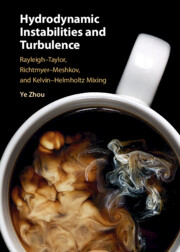 Hydrodynamic Instabilities and Turbulence
Hydrodynamic Instabilities and Turbulence Book contents
- Frontmatter
- Dedication
- Contents
- Preface
- Acknowledgments
- Part 1 Fundamentals
- Part 2 Hydrodynamics of Complex Flows
- 9 Influence of initial conditions
- 10 Flow properties
- 11 Rotation and time-dependent acceleration
- 12 Direction, strength, and shape of incident shock waves
- 13 Reshock andmulti-shocks
- 14 Combined instabilities
- 15 Geometrical configurations
- 16 Convergent/divergent geometry
- 17 Magnetohydrodynamic fluid instabilities
- Part 3 From the Microscopic to Cosmic Scales
- References
- Index
10 - Flow properties
from Part 2 - Hydrodynamics of Complex Flows
- Frontmatter
- Dedication
- Contents
- Preface
- Acknowledgments
- Part 1 Fundamentals
- Part 2 Hydrodynamics of Complex Flows
- 9 Influence of initial conditions
- 10 Flow properties
- 11 Rotation and time-dependent acceleration
- 12 Direction, strength, and shape of incident shock waves
- 13 Reshock andmulti-shocks
- 14 Combined instabilities
- 15 Geometrical configurations
- 16 Convergent/divergent geometry
- 17 Magnetohydrodynamic fluid instabilities
- Part 3 From the Microscopic to Cosmic Scales
- References
- Index
Summary
There are a number of microphysics and transport processes that can be extremely important to suppress or enhance the growth of these instabilities. I will provide a detailed description of how the hydrodynamic instability evolutions can be modified by incorporating the viscosity, surface tension, diffuse interface, and compressibility of the flows into the governing equations and growth rates.
Keywords
- Type
- Chapter
- Information
- Hydrodynamic Instabilities and TurbulenceRayleigh–Taylor, Richtmyer–Meshkov, and Kelvin–Helmholtz Mixing, pp. 183 - 213Publisher: Cambridge University PressPrint publication year: 2024
